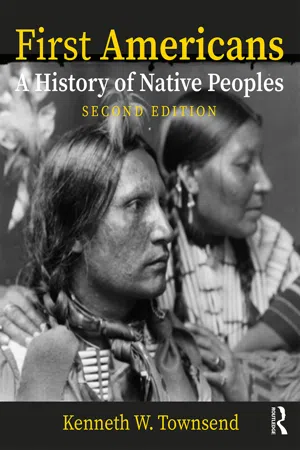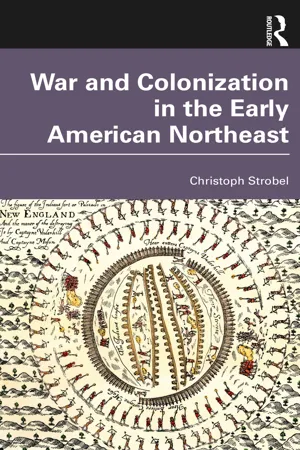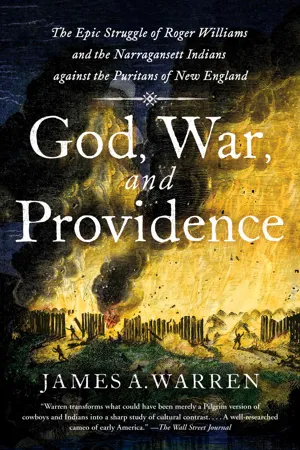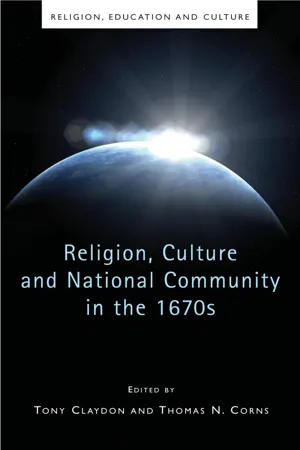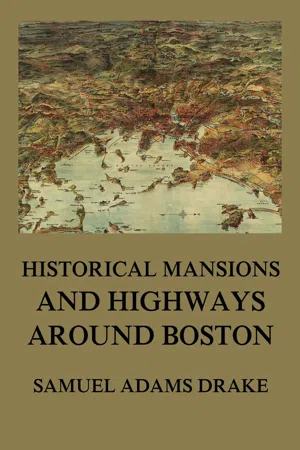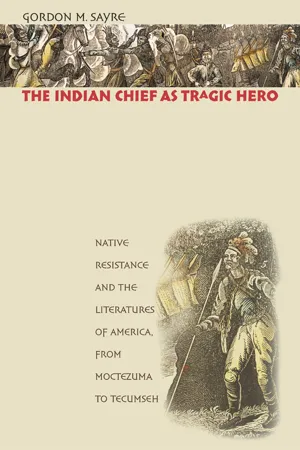History
Metacom's War
Metacom's War, also known as King Philip's War, was a conflict between Native American tribes and English colonists in New England from 1675 to 1678. It was sparked by tensions over land, resources, and cultural differences. The war resulted in significant loss of life on both sides and had a lasting impact on the region's demographics and relations between Native Americans and colonists.
Written by Perlego with AI-assistance
Related key terms
Related key terms
1 of 4
Related key terms
1 of 3
9 Key excerpts on "Metacom's War"
- eBook - ePub
First Americans: A History of Native Peoples, Combined Volume
A History of Native Peoples, PowerPoints
- Kenneth W. Townsend(Author)
- 2018(Publication Date)
- Routledge(Publisher)
Although she lived in relative isolation, she joined a group of Catholic Five Nations women who devoted themselves to chastity, fasting, self-flagellation, and constant exposure to the pains of hot and cold. In 1680, she died at the age of 24. In death she became a powerful symbol to both Jesuits and Mohawks. She was a woman, Native American but a devout Catholic, whose devotion to the faith was as strong as any Jesuit in New France. Kateri, in life and death, blurred cultural boundaries.Maturing Colonies Ending a Century in Conflict: Metacom’s War and Bacon’s Rebellion
Relative to population, King Philip’s War was the deadliest conflict ever fought on American soil. Almost half of all towns in New England burned to the ground. In contrast, Bacon’s Rebellion was not so much an Indian war as a series of raids and counter-raids between Indians and colonists that sparked a larger rebellion of small farmers against Virginia’s elite planter class. In both cases, however, the fighting reflected the changing relations between and among native peoples and Anglo-Americans, as well as social and economic developments in the northern and southern colonies. Both conflicts weakened smaller Indian groups, who fell under the control of the Anglo-Iroquois Covenant Chain alliance extending into New England and as far south as Virginia. Both New England and Virginia had maturing economies and governments led by wealthy elites who asserted newer forms of racial and class authority over imported African slaves and small farmers. And although still interested in the highly lucrative trades with interior Indians for furs and pelts, after King Philip’s War and Bacon’s Rebellion, colonists in both regions pushed to the margins any Native Americans remaining within their borders.Metacom’s WarThe rapidly growing population of Britain’s North American colonies created intense pressure on native peoples, and this was a key factor in the outbreak of Metacom’s War (1675–1676), also known as King Philip’s War. As the British population grew naturally and from continued immigration, so did its need for more land and the construction of more towns. Settlers cut down trees, cleared forests, and dammed rivers. Following English tradition, each town had a commons area, an unfenced piece of land where all townspeople could let their pigs and cows graze. Additional grazing ranges surrounded these new towns, as did additional lands for farming by both community residents and outlying families. Forests which were once the exclusive domain of native hunters now fell under the English gun. All that Native Americans knew, all they valued, and, indeed, their very identity, was now threatened by a growing English population. For native peoples, the paradise of the colonists’ new “Canaan” was an ecological disaster zone. - eBook - ePub
- Christoph Strobel(Author)
- 2020(Publication Date)
- Praeger(Publisher)
14 King Philip’s War is, however, not only of relevance in terms of national history as Mandell points out but is also of importance in the history of indigenous–Euro-American relations of New England. While in the southern portion of the region King Philip’s War crushed Native Americans’ ability to resist militarily, in the northern reaches of Dawnland this conflict was merely one war among many.100 Years of WarsBetween King Philip’s War and the American Revolution, the Native Americans of New England were tied into four major wars that the colonists referred to as King William’s War (1688–1697), Queen Anne’s War (1702–1713), King George’s War (1744–1748), and the French and Indian War (1754–1763). These conflicts were actually North American tangents of broader European, Atlantic world, and sometimes global wars. European and world historians thus refer to King William’s War as the War of the League of Augsburg (or the War of the Grand Alliance), Queen Anne’s War as the War of Spanish Succession, King George’s War as the War of Austrian Succession, and the French and Indian War as the Seven Years’ War (as it lasted in the European theaters from 1756 to 1763). These series of wars were part of a struggle between Britain and France over who would be the dominant power in Europe. They took place in Europe, but the rivalry also played itself out in a global theater as the two powers competed over and tried to strengthen their colonial holdings around the world. The Atlantic Northeast was at the center of the Anglo-French competition over power, and the Native Americans of New England often found themselves in the middle of this global war. This rivalry also played itself out in smaller regional conflicts such as Dummer’s War (1722–1727), during which the Wabanakis in northern New England attempted to push back English colonization efforts. This proliferation of conflicts meant that many of the indigenous people of Dawnland lived through an almost continuous era of war. - Christoph Strobel(Author)
- 2023(Publication Date)
- Routledge(Publisher)
31King Philip’s War plays a contentious role among historians engaged in the debate about the strategic conduct of Anglo Americans on the battlefield, and in their arguments of whether English colonists “Americanized” their conduct in conflict through the adoption of Native American tactics, or, if they continued to stick to European ways of fighting. Some historians argue that the English won this conflict by adopting Native American’s tactics and modes of fighting.32 Other scholars maintain that the English colonists’ adaptation of Indigenous ways of war were quite limited, had limited effectiveness, and their impact on the outcomes of the conflict were overblown. This school of thought argues that European combat behavior and strategies continued to prevail through King Philip’s War and beyond.33This same question was also debated among New English colonists during King Philip’s War. The seventeenth-century colonist and observer William Hubbard, for instance, dismissed efforts to adopt Native American fighting styles. He used the heavy casualties suffered by a force of colonists whose commander had “taken up a wrong notion about the best way and manner of fighting with the Indians,” as a lesson why such behavior was fraught with problems for the English. This officer, according to Hubbard, had ordered his “Company” to fight “with the Indians in their own way,” by “skulking behind Trees and taking their aim at single persons.” Hubbard advocated for colonists to reject Native American battlefield conduct and “to March in a body,” as practiced in European warfare. To Hubbard fighting in close European battlefield formation was not only strategically but also morally superior. Indigenous warfare distinguished itself in little more than “subtlety and cruelty.”34 Other colonists advocated different solutions. Realizing that too often English forces had been challenged and suffered heavy casualties during combat in wetlands or forests when marching in close formation, Benjamin Church, a New English colonist and military officer, came to advocate a different strategy. He advised the colonies that “if they intended to make an end of the War, by subduing the Enemy, they must make a business of the War, as the Enemy did.”35- eBook - ePub
- Armstrong Starkey(Author)
- 2002(Publication Date)
- Routledge(Publisher)
Chapter FourTotal war in New England: King Philip’s War, 1675–6 and its aftermath
King Philip’s War
The end came for the New England colonists’ most feared enemy on 12 August 1676. The Wampanoag sachem Metacom, better known among the English as King Philip, was at last brought to bay in a swamp near his home at Mount Hope (now Bristol, Rhode Island) bordering Plymouth colony. His relentless pursuer was one of the most notable frontier commanders in American history, Captain Benjamin Church (1639–1718), leader of a picked company of English and friendly Indians. While we know nothing of Philip’s thoughts on this fateful day, he must have been exhausted and demoralized. The uprising which bears his name was in collapse and Church had already captured his wife and son. Philip’s own followers were falling away and, indeed, it was a deserter who led Church to his camp on the swamp’s edge.It was still dark as Church’s company advanced on the enemy position. One detachment was ordered to crawl on their stomachs as close to the camp as possible, taking care not to fire until first light to avoid hitting friends. Once discovered, they were to fire and fall on the enemy, each man shouting and making all the noise that he could. Church knew that, at the first sound of gunfire, Philip would flee into the swamp, a tactic that had often enabled him to avoid pursuit. Therefore he arranged an ambush placing Englishmen and Indians in pairs behind trees in the swamp, ordering them to kill anyone who should approach silently. Once he made this disposition, Church was confident that Philip was in his grasp. He took a brother officer by the hand and announced: “Sir, I have so placed them that ‘tis scarce possible Philip should escape them.”Suddenly a shot whistled over their heads. Captain Golding, the officer leading the assault party, had feared discovery by an Indian who had risen to relieve himself. His shot provoked a volley by the entire party which overshot the enemy Indians, who had yet to rise from sleep. Almost immediately they fled into the swamp, Philip himself rushing upon one of the ambush positions. He was struck twice in the chest by musket bullets and collapsed in the mud. He had been killed by an Indian. Church awarded Philip no honours of war. Instead he called his “old Indian executioner” and ordered him to behead and quarter the body. “Philip, having one very remarkable hand, being much scarred, occasioned by the splitting of a pistol in it formerly, Captain Church gave the head and that hand to Alderman, the Indian who shot him, to show to such gentlemen as would bestow gratuities upon him. And accordingly, he got many a penny by it.” It was thus that Philip, a symbol of fierce savagery and a name at which the world grew pale, was transformed into a curiosity.1 - eBook - ePub
God, War, and Providence
The Epic Struggle of Roger Williams and the Narragansett Indians against the Puritans of New England
- James A. Warren(Author)
- 2018(Publication Date)
- Scribner(Publisher)
Chapter 9“In a Strange Way”: King Philip’s War
Paul Revere’s engraving of King Philip of the Wampanoags. Philip initiated the conflict that bears his name, but he didn’t exercise control over the trajectory of the conflict for very long.O n June 24, 1675, the chief sachems of the Narragansetts—Pessacus, Ninigret, Quinnapin, and Quaiapen, the sister of Ninigret—met with Roger Williams and three emissaries from the General Court of Massachusetts on the shore of Worden Pond, twelve miles southwest of Cocumscussoc. A crisis was at hand. Metacom—known to the English as King Philip—the son of Massasoit, great sachem of the Wampanoags, was on the verge of war with Plymouth Colony. Massachusetts and Plymouth had rapidly dispatched representatives to the major Indian tribes in the region. They wanted assurances from their sachems that their warriors would not join Metacom in an uprising, if, indeed, one was in the offing.Would the Narragansett confederation remain at peace?According to Williams’s account, the sachems were well aware of the crisis. They reported that “they had not sent one [warrior], nor would: that they had prohibited all their people from going on . . . [to Philip’s] side: that those of their people, who had made marriages with [the Wampanoags] should return or perish there: That [if] Philip or his men fled to them yet they would not receive them but deliver them up unto the English.”1This was all reassuring news to Williams and the emissaries from Massachusetts. But it was not the whole story. In fact, the Narragansetts were deeply conflicted about whether to join Philip’s uprising. Ninigret was by now in his late sixties. He had wrestled with the problem of ascending English power for decades and had in recent years found himself in weighty discussions of the English problem not only with his fellow Narragansett sachems and Philip, but with sachem Robin Cassacinamon of an independent band of Pequots near New London, and, astonishingly, even with Uncas. - Tony Claydon, Thomas N. Corns(Authors)
- 2011(Publication Date)
- University of Wales Press(Publisher)
In the difficult early decades of the New England colonies, as these two brief anecdotes are meant to illustrate, the fundamental distinction to be drawn was between the godly and the ungodly, the churched and unchurched; in the drawing of such lines there was to be found bitter acrimony and physical violence aplenty, as the familiar ordeals of Williams, Samuel Gorton, or Anne Hutchinson illustrate. Massachusetts Bay, Plymouth and Providence were rival actors in the colonial theatre, each pursuing fortuitous trade alliances, opening new markets, upholding distinct ecclesiastical settle ments, and managing an alwaysshifting web of treaties and accom modations with the Narragansett, Nipmuck, Wampanoag, Mohegan and other tribes, themselves always renegotiating their alliances. During the 1650s and 1660s, an uneasy and fragile ‘middle ground’ developed, only to be shattered during the late summer of 1675, when a smallscale Wampanoag rising toppled over into a theatrewide conflict notable for its shocking brutality.‘King Philip’s War’ burst into life in June 1675, notionally instigated by the Wampanoag sachem Metacom (alias Philip) as a reprisal for the trial and execution of three of his lieutenants, who had been accused of murdering John Sassamon (a Wampanoag convert of dubious character).1 Fourteen months of startling and symmetrical violence followed. Armed bands razed settlements to the ground, put families to the sword, took scalps and limbs as trophies, tortured the living, defiled the fallen and enslaved the survivors. The conflict was organized along racial lines, and as it evolved those racial lines hardened; Narragansetts, for instance, under the princely sachem Canonchet, began the conflict in an uneasy alliance with Plymouth but were forced by the sword into Philip’s coalition. Frustrated by the inability to distinguish between friend and foe, in August 1675, soon after the onset of hostilities, the Massachusetts Bay government confined its praying Indians to their plantations and appealed for the killing or capture of enemy combatants: ‘it shall be lawful for any Person, English or Indian, that shall find any Indians Travelling or Sculking in any of our Towns or Woods … to command them under Guard and Examination, or to Kill and destroy them as they best may or can’.2 King Philip’s War, for English colonists living through and committing atrocities, was arguably a race war (Slotkin, 1973 argues this point; see also Oberg, 1999: 158). The horizontality of ungodliness (or its affirmative counterpart) was replaced, as Jill Lepore (1998: 81–2) has documented, with a profound terror of any such filiation between English and Indian. Because in the early modern period racial identity was perceived to be relatively fluid rather than fixed immutably, the fear of ‘going native’ was more than a metaphor: if the climate, diet and other physical factors had pressed the Indians into savagery, what was to prevent the English soldier from the same fate?3 From cruelty in combat (scalping) to the use of Indian tactics (skulking), from diet (groundnuts, bear jerky) to weather (freezing rain), the English body was vulnerable to the physical and moral effects of the New England wilderness.4- eBook - ePub
Red Ink
Native Americans Picking Up the Pen in the Colonial Period
- Drew Lopenzina(Author)
- 2012(Publication Date)
- SUNY Press(Publisher)
3 King Philip's Signature Ascribing Philip's Name to Land, War, and History in Native New England (1660–1709) Surely then we have many of us cause to tremble. How sad it is to consider, that an Indian should write a letter to an Englishman and thus express himself, “When any hurt is done, you say that we have done it though we never did wronge to English-men and hope we never shall.” —Increase Mather, An Earnest Exhortation to the Inhabitants of New England To all Christian People to whom these presents shall come, Phillip, allies [alias] Metacom Cheiffe Sachem of Pocanakett in the Collonie of New Plymouth in New England sendeth Greeting. —Philip (Metacom), opening refrain in numerous land transactions between Philip and the colonists Written in Stone: Colonial Contests for Meaning On November 20, 1701, the Puritan minister Cotton Mather wrote in his diary how “I dare not go any longer, without my old Methods, of Praying with Fasting in secret Places … [to] address the Lord for His Blessing on my Church-History … which He has helped me to write, of His glorious Works in these American churches.” 1 Mather had embarked upon the writing of the Magnalia Christi Americana, his massive deterministic history of the Church of New England, and was engaging in something not unlike a vision quest, a secret fast, calling upon his God in a most private ritual to grant him the power and strength for the task ahead. Some twenty-five years earlier the sachem of the Wampanoag Nation, Metacom or Philip, may have undertaken a similar quest to determine the history of his people as well as a course of action that might lead them through the treacherous space of his contested, increasingly colonized homeland. He too must have fasted and sweat, sought spiritual counsel and called upon his spirit helper, or manitou, for power and strength to plot the difficult path before him - eBook - ePub
- Samuel Adams Drake(Author)
- 2017(Publication Date)
- Jazzybee Verlag(Publisher)
X. KING PHILIP'S WAR.Middlesex had now attained a high degree of prosperity. Nearly half a century had elapsed since the landing at Charlestown. The handful of original settlements were already old; a new generation, native to the soil, was replacing the first comers; in population, resources, and influence the old shire had steadily advanced, and with that progress as constantly maintained her high character as one of the soundest and stanchest constituents of the commonwealth. But at this period the colony was called upon to meet a new danger, and to encounter reverses in which Middlesex bore a heavy share.Moreover, the natives were no longer the despicable foes the English had found them forty years before. They had firearms, and knew how to use them.What is known as Philip's War may be regarded as a most determined attempt to destroy the English, made by a chieftain able to grasp the idea that either they or his own nation and race must disappear. The haughty Philip had been made to feel that he was a mere vassal of the English. His unconquerable spirit revolted at the yoke. His endeavor to unite the New England nations in one desperate effort to free themselves from this galling subjection was the work of a great mind. The English had themselves furnished the idea of combination. They had confederated against the Indians, why not the Indians against the English?In celerity of movement, ability to encounter and resist hardship, craftiness in planning surprises, and in general knowledge of the country, they far surpassed the whites, whose tactics compelled them to act in a few large bodies, while the numerous small parties of the enemy spread devastation among the scattered frontier settlements, and by their appearance in some unexpected quarter confounded their assailants and their plans. Fortunately for them, perhaps, Philip was unable to accomplish his grand design of an Indian confederacy against the English to the extent he meditated. - eBook - ePub
The Indian Chief as Tragic Hero
Native Resistance and the Literatures of America, from Moctezuma to Tecumseh
- Gordon M. Sayre(Author)
- 2006(Publication Date)
- The University of North Carolina Press(Publisher)
Chapter 1: From Enemy to Hero
Metacom, the Wampanoag chief called King Philip by New England colonists, was regarded as a demonic villain during the bloody war of 1675-76, “a Salvage and a wild Beast” to be “hunted by English forces through the Woods” (Hubbard 1:265). Yet in the early 1800s, numerous histories, novels, plays, and orations portrayed Metacom as a brave leader fighting for native independence. Black Hawk, who was pursued and captured in 1831-32 by an army of U.S. troops, was subsequently taken east to meet President Andrew Jackson. In Baltimore, the “Indians and the president attended the theatre the same night, and it was remarked, that the attention of the house was pretty nearly equally divided between them. . . . Considerable inconvenience was experienced from the meeting of two such conspicuous characters as the president of the United States and Black-hawk, at the same time, in populous places”—so much “inconvenience” that the Sauk leader’s departure for Philadelphia was delayed so that President Jackson might go ahead unchallenged. Later, when Black Hawk reached New York and Albany, the crowds wishing to see him were so thick that he could scarcely proceed from the ferry landing into the city.1 Tecumseh led the native resistance to the U.S. military invasion of the Old Northwest in 1810–11 and fought with the British in some of the largest battles of the War of 1812, yet shortly after his death in 1813, a Dayton, Ohio, newspaper called him “perhaps the greatest Indian general that ever lifted a tomahawk” (Dayton Republican , 25 October 1812, qtd. in Sugden 395), and in 1820 a Vincennes, Indiana, newspaper published a letter declaring that “every schoolboy in the Union now knows that Tecumseh was a great man. . . . As a statesman, a warrior and a patriot, take him all in all, we shall not look upon his like again” (Indiana Sentinel
Index pages curate the most relevant extracts from our library of academic textbooks. They’ve been created using an in-house natural language model (NLM), each adding context and meaning to key research topics.
Explore more topic indexes
Explore more topic indexes
1 of 6
Explore more topic indexes
1 of 4
